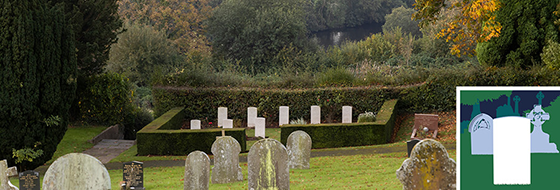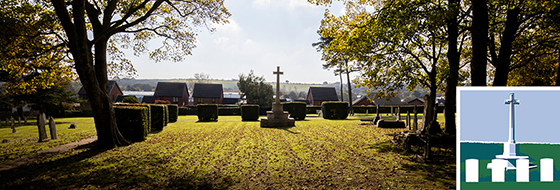Gloucester Old Cemetery
Amongst the many thousands of civilian burials here are over 250 Commonwealth War Graves, two thirds from the First World War and one third from the Second.
![]()
Gloucester Old Cemetery, also known as Tredworth Road Cemetery, lays just over a mile from Gloucester city centre. It covers an area of some 35 acres divided in two by the Tredworth Road. Amongst the many thousands of civilian burials here are 254 Commonwealth War Graves, 158 from the First World War and 96 from the Second. There are also seven war graves of other nationalities within the war cemetery one Belgian, two German, two Italian and two Polish.
Find out more
A Tale of Two Halves
Prior to the First World War, the Territorial Force was formed of part-time volunteer soldiers to back up the regulars of the British Army. Auxiliary medical care was also organised at the same time and suitable hospitals were identified in all major towns in Britain with medical schools as well as other centres where large provincial hospitals could be called into use in the event of war.
Gloucestershire had thirty hospitals, the largest of which was Gloucester Voluntary Aided Hospital, run by the Red Cross, which came under Southern Command’s 2nd General Hospital in Bristol. The Gloucester VA Hospital occupied the Gloucester Union Workhouse from 1914 and later became the Gloucester Royal Infirmary. It had 272 beds and over the course of the war 4,822 patients were admitted, of whom 31 died. Some of those are buried in Gloucester Old Cemetery in one of the three First World War plots, the largest of which has a Cross of Sacrifice, in the older part of the cemetery on the northside of the Tredworth Road.

Gloucester V.A. Hospital, Lower Ward ©
The majority of those buried in the cemetery are local men with familial connects to Gloucester and the surrounding area, some 41 of whom served with the Gloucestershire Regiment, while others came from further afield including three Australian, two Canadian, and one South African servicemen. They died of wounds received on the fighting fronts, of sickness, or from accidents. Private Frank Wallace Drew of the 2nd Battalion, Machine Gun Corps (Infantry) who died at the Royal Gloucester Hospital on 11 November 1918, of pneumonia likely as a complication from having contracted influenza during the great pandemic, known as Spanish Flu, which ravaged the world in 1918 and 1919. He left behind a wife Charlotte and a three year son Henry Francis.
In 1940 the cemetery authorities received a request for further anticipated war grave burials and land was set aside in the newer part of the cemetery known as ‘Section B’ on the southside of Tredworth Road. This second world war plot is also marked by a Cross of Sacrifice. During the war the city’s hospitals once again took service casualties. The City General Hospital had a military wing and several of the men died there, while others died in the RAF Hospital at Innsworth. During the war Gloucestershire was home to more than 20 airfields and half of the Second World War service burials are of airmen but also of three airwomen who served with Women's Auxiliary Air Force. A fourth women Third Officer Monica Joan Pearson served with Women's Royal Naval Service at HMS Godwit, the Fleet Air Arm Training facility at Hinstock airfield, in Shropshire.
Visit Gloucester Old Cemetery
The cemetery is located on Tredworth Road, Gloucester. Before visiting we recommend you visit:
The website of the Site Authority

This example of a grand Victorian garden cemetery is where the CWGC commemorates more war dead than anywhere else in Bristol. Many were buried by their next of kin, but others are far from home indeed
Bristol (Arnos Vale) Cemetery
Opened in 1859, this is the final resting place of over 700 Commonwealth and Allied servicemen and women of the two world wars.
Cardiff Cathays Cemetery
Visit the largest group of war graves in this part of Mid Wales. Thirteen servicemen of the First World War and eleven of the Second lie here, most of them under the familiar CWGC pattern headstone.
Brecon Cemetery
Owned by the MOD but cared for by the CWGC, come and visit a century’s graves of men of the army, navy and air force. Forty are First World War graves, while 33 were buried here between 1939-1947.
Pembroke Dock Military Cemetery




